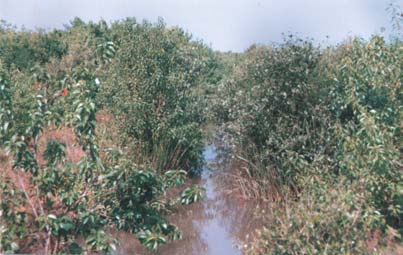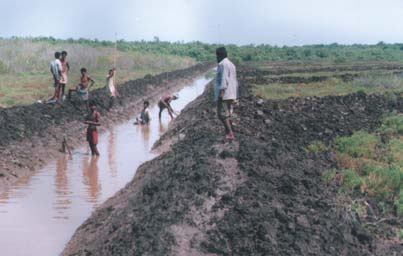Overview
This project was launched in Andhra Pradesh with the aim of inducing concerted action towards conservation and sustainable management of the mangrove wetlands on the east coast of India. The restoration employed canal techniques, instead of simple plantation of seedlings, and a fish bone pattern of canals was utilized. This fishbone design was shown to be a more efficient method of facilitating tidal flushing than the rectangular pattern used by the Forest Department. Thus, this technique has now been adapted and recommended by the Government of India for other restoration projects.
Quick Facts
Project Location:
Andhra Pradesh, India, 15.9128998, 79.73998749999998
Geographic Region:
Asia
Country or Territory:
India
Biome:
Coastal/Marine
Ecosystem:
Estuaries, Marshes & Mangroves
Area being restored:
520 hectares
Organization Type:
Other
Location
Project Stage:
Completed
Start Date:
1997-05-29
End Date:
2004-05-29
Primary Causes of Degradation
Fisheries & Aquaculture, Mining & Resource Extraction, Urbanization, Transportation & IndustryDegradation Description
There are several factors contributing to the degradation of Andhra Pradesh’s mangrove forests. Until 1972, mangroves were clear felled in many parts of the region, and these areas have not been able to regenerate due to topographic changes. Not only that, the Krishna river is one of the heavily utilized rivers in peninsular India and is exploited for a variety of purposes. As a result, there has been a reduction in fresh water flow over a period of time, which has had a telling impact on the growth and regeneration of mangroves.
Another important contributor to ecosystem degradation is the rapid siltation and pollution of Kakinada Bay, as evidenced by a recent hydrographic study. With increased developmental activities and the establishment of fertilizer units, some effluents are being discharged into the bay. This has resulted in high amounts of ammonium and nitrate in bay waters, which may be contributing to degradation. Furthermore, the present depth of the bay is very low, and there is hardly any lateral mixing of waters. Therefore, there is a lot of stagnation in the bay which may also be affecting the mangroves.
A variety of anthropogenic activities has compounded these environmental conditions and has helped hasten the decline of the mangroves. Coastal villagers utilize mangroves for their basic needs such as firewood, fodder, fencing, house construction, thatching and fishing poles. Mangrove forests are also being converted into aquaculture ponds, salt pans and paddy fields with increasing frequency.
Project Goals
To obtain greater commitment for the joint management of mangroves by the forest departments of these states in tandem with the local communities.
To enhance the capacity of the local communities to manage mangrove resources
To reduce the pressure on the mangroves by demonstrating viable economic alternatives
Monitoring
The project does not have a monitoring plan.
Stakeholders
“Microplans” were prepared in the respective villages for the restoration of these degraded mangroves. Hydrologic and geomorphologic reasons for degradation were discussed with the communities in order to enhance their scientific awareness of mangrove restoration. The Mangrove Management Units (MMU), which include both degraded areas for restoration and the pristine mangroves for management, were identified for each Village Level Institution (VLI). The VLIs were trained in nursery raising and digging canals, and the restoration activity was carried out with the cooperation.
Description of Project Activities:
A survey of the entire Godavari and Krishna mangroves was carried out in order to identify the degraded areas. Restoration began with the digging of canals to reduce salinity, facilitate tidal flushing, and drain stagnant water. A fishbone design was utilized in order to facilitate easy inflow and outflow of tidal water. The main canals were dug at an angle of 45º to the natural creek, and the side canals were dug at an angle of 30 º to the main canal. The canals were dug in a trapezoidal shape in order to plant the saplings at the mid level of the canal. This is to ensure that the plants receive tidal water, but at the same time they are not submerged. The distance between side canals was 12.5 m during the first year of plantation; however, in subsequent years, this distance was reduced to 8 m in order to ensure a dense canopy.
After a buffer period of three months, nursery-raised mangrove saplings were planted along the trapezoid-shaped canals in the degraded areas. The planting was done in October and November, after the southwest monsoon, as the influx of rainwater during this period reduces the salinity of the soil. The eight-month-old saplings were planted along the slopes of the canals (20-25 cm from the top) with a gap of 2 m. The species Avicennia marina, Avicennia officinalis and Excoecaria agallocha were selected for planting, as these species tolerate a wide range of salinity. Aegiceras corniculatum, Bruguiera gymnorrhiza, Rhizophora apiculata, Rhizophora mucronata and Xylocarpus moluccensis were also planted in order to ensure genetic diversity.
Ecological Outcomes Achieved
Eliminate existing threats to the ecosystem:
A total area of 520 ha of degraded mangroves was restored in the Godavari and Krishna mangroves. Initially the growth rate of new seedlings was slow, but after 2 to 3 years their growth rate had improved.
The bio-diversity of the area has been positively impacted by the restoration. The crab population in the restored areas has increased due to the increased water regime. As biodiversity has improved and the denuded patches have been covered with mangroves, populations of larger animals like otters have also increased substantially. In addition to this, the bird population has shown an increase since the project began.
With the improvements made in hydrology, further degradation of mangroves has stopped. Mangroves are now naturally regenerating, and the canopy cover has become denser, as evidenced by remote sensing images taken recently.
Factors limiting recovery of the ecosystem:
(None given)
Socio-Economic & Community Outcomes Achieved
Economic vitality and local livelihoods:
As mentioned above, the newly established water regime has increased the population of edible crabs in the restored areas, and this is a benefit for the livelihood of local communities. There has also been good growth of fodder grass which has helped the local community in feeding their livestock.
Key Lessons Learned
Providing alternate employment and income generating activities to the villagers depending directly on mangroves has been an important aspect of this project. Micro-enterprises that use the local resources like dairying, rope making using coir fibers, fish vending, etc. have been found to have considerable employment potential. However, a major difficulty has been the non-availability of resource persons/institutions to identify and provide training in appropriate micro-enterprises in the local villages.
Long-Term Management
An area of 9,442 ha is currently under the management of eight village level institutions. Moreover, NGOs (namely Sravanthi, Action in Godavari area, Sangamithra Service Society and Coastal Community Development Program in Krishna) were trained in restoration techniques and in participatory approaches for community mobilization and mangrove management. These NGO’s have since restored 215 ha of degraded mangroves.
Sources and Amounts of Funding
Approximately 3,010,000 dollars India-Canada Environment Facility (ICEF) Contribution – $ 2,726,666
(The remaining balance was contributed by other sources.)
Other Resources
M.S. Swaminathan Research Foundation
http://www.mssrf.org/
India-Canada Environment Facility
http://www.icefindia.org/



